‘As Victoria Beckham turns 50, I trained with her PT and here’s what he taught me’
Former Spice Girl, fashion designer and bona-fide cool girl, Victoria Beckham, turns 50 today, and it seems like she's just getting started, not least when it comes to her fitness.
Last year, she unveiled that she was in her 'strength-training phase', after reportedly favouring cardio - she even dropped on social that she'd mastered the impressive feat of an overhead barbell squat. Damn.
She's been working out with husband David's PT, Bobby Rich, and so I went to him to find out some of his programming protocol. Here are eight things he taught me, plus a full breakdown of the workout he programmed for me.
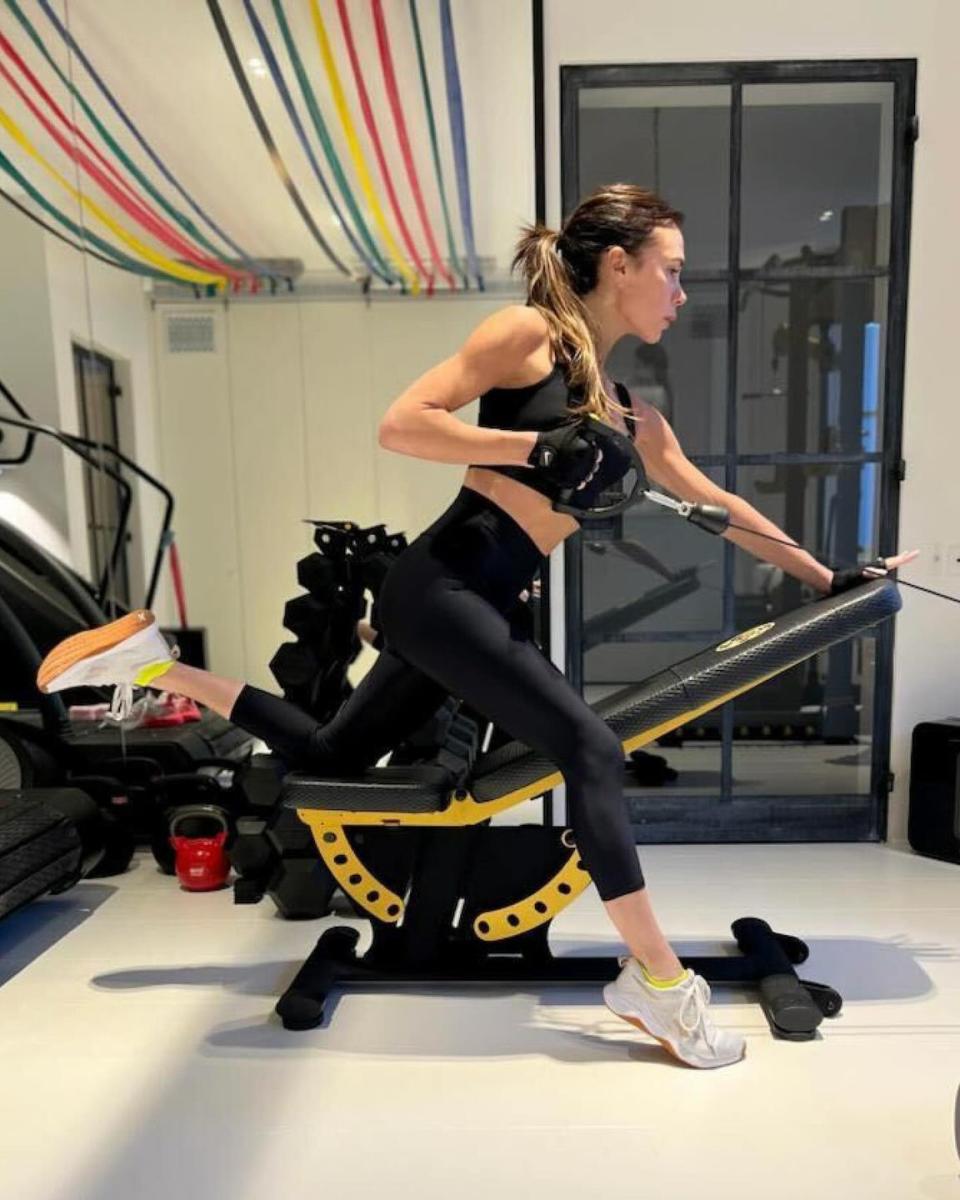
1. We should be able to perform five fundamental movements
Bobby believes there are five foundational movements we should be proficient in:
press off the floor (e.g. squat)
pulling off the floor (e.g. deadlift)
pressing weight away from you (e.g. chest or bench press)
rotation
'For individual performance in day-to-day life, [even before considering training] in sport, we need to be strong in these foundations,' Bobby says.
'People sometimes turn their noses up when they hear "fundamental" or "foundation", because they think it's "beginner chat",' he continues, 'but we can't do any of those "impressive" movements that you might see without making sure our basics are solid.'

2. Victoria makes workouts a 'non-negotiable' but she rests up, too
Exercising from Monday to Friday is a must for Victoria, who trains 'significantly hard', notes Bobby, but she'll make sure to take Saturday and Sunday off as that's what works for her schedule and makes it sustainable.
His other top tips? 'Sleep - I constantly check in on sleep. I want to know that my clients feel rested,' says Bobby.
3. Victoria integrated strength training gradually
VB's interested in strength training started when Bobby began to train husband David and Victoria became interested in some of the movements they were practising. 'The integration came through introducing Victoria to new movements that she was curious to try and answering questions,' says Bobby.
First, Bobby helped her to focus on 'form', and showed her exercises using lighter loads. Then, over time, they used progressive overload - 'a slight incremental increase in training stress on top of another, session after session, week after week, so you continue to improve,' according to Andy Vincent, a strength and conditioning coach - increasing the training stimulus through volume and intensity, to build up her fitness.
VB used to do a lot of cardio, but Bobby confirms that, in recent years, 'there's been a big shift to focus on and strength and resistance'.
4. The focus of Victoria's training session varies over the stages of a training cycle
Victoria's training is periodised into specific blocks with different foci to meet her strength-training goals. 'Weight training takes a while to reap the rewards and the benefits', Bobby also adds, so these blocks are long enough to deliver results if followed consistently.
One cycle might be centred around hypertrophy (increase in muscle size or strength through resistance training); another strength; another might be power and endurance, elucidates Bobby. All blocks last roughly around six to 10 weeks, adjusting for clients' responses to training and schedules.
The sessions may follow this format:
a) Strength session
With strength sessions, we want 'two to two-and-a-half, even three minutes of rest in between each set,' says Bobby. So they may take up to 90 minutes. These workouts are 'heavier and slower', with the aim being to lift in the four-to-six-rep range.
b) Power
'Short and sharp', with a warm up and cool down, Bobby says these sessions could be just 30 minutes. 'The weights are a bit lighter [than in strength, though still heavy], and you're trying to move the weights that much quicker'. You can still be working within a six-rep range.
c) Endurance
These session are 'lower intensity, higher volume,' says Bobby, with reps performed with lighter weights in the range of 20 and above.
5. Victoria still includes cardio warm ups
Even though VB now doesn't rely solely on cardio workouts, Bobby says that they sometimes warm up with cardio.
In a strength session with very heavy weights (four to six-rep region), they'll 'strip back most of the cardio' - apart from a 'steady, 10-minute warm up' in the form of a run or on the StairMaster to get her body temperature up - and then do only some mobility, so that the majority of the workout features just heavy lifting. He won't have clients doing a high-intensity cardio warm up, where their bodies will 'become full of lactic acid'.
After the cardio warm up, or if clients don't have time for that, Bobby primes the muscles that will be put to work in specific exercises within the main strength workout, by doing lighter-weight versions of those exercise. For example, if clients are doing three to four sets of squats in their main session, he'll start with a set or two with just the barbell, or using lower weight than those they'll use in the main portion of the workout.

6. How you combine strength and cardio depends on the individual
Bobby trains his clients like athletes, looking at the year ahead, not with the end goal of performing at a sporting event, but for life.
While 'it's beneficial to be cardiovascularly fit and strong at the same time,' how this is broken up in a training routine is 'individual', says Bobby. 'If you're strong already and have done a lot of resistance training, you may just want to focus on cardio, or vice versa.'
Time is also a big factor, he continues. 'If you've got time for five sessions across a week, then you can get a good balance of both strength and cardio; if you've only got time for two or three, then prioritise what's important.'
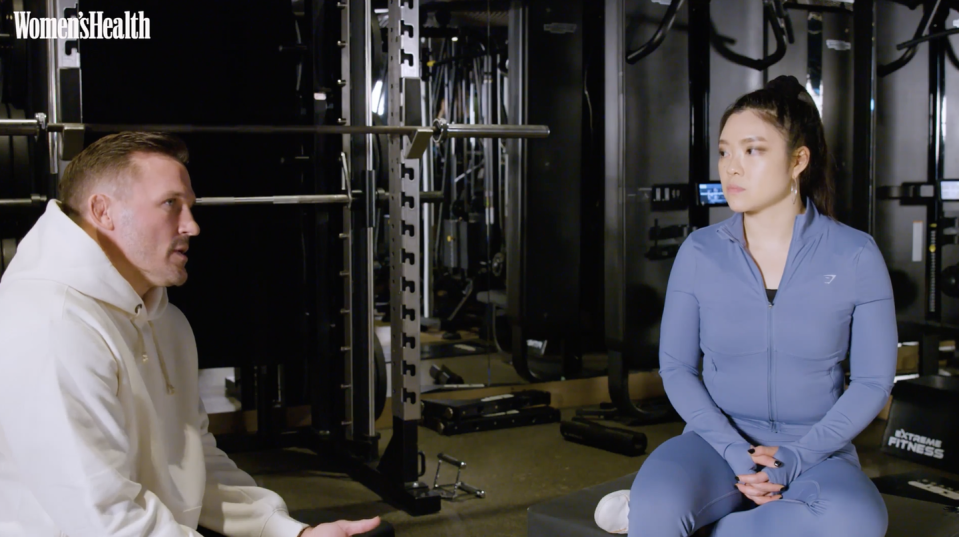
7. Remote sessions means Victoria can remain consistent
'We're lucky in this day and age that if there's a lot of travel and extreme time zones on someone's schedule, we can do remote [sessions]', says Bobby, which means that it's easier for clients, especially stars like Victoria with A-list schedules, not to miss a workout.
Confidence is also a challenge that his clients face with remaining consistent. Bobby advises going back to a few of those fundamental movements that you can build on and starting slower.
8. Sticking to a realistic and sustainable routine will keep you on track
Don't 'overpromise' or be overambitious about what you can achieve, advises Bobby. Look at your schedule and find 'what balance looks like'.
'If you're currently not training at all or once a week, don't think you're going to do five days - maybe do twice or thrice a week'. Keep it manageable. Also, 'find something you love', Bobby says. He's more of a proponent of 'keeping moving' and 'being fit' generally than focusing on one particular style, as if you don't enjoy it, 'you're not going to keep it up'.
Here's a full breakdown of the workout Bobby and I did together, replicated from his sessions with Victoria:
a) Landmine rotational press with split-squat stance
A large movement that incorporates 'pull, press, and rotation'
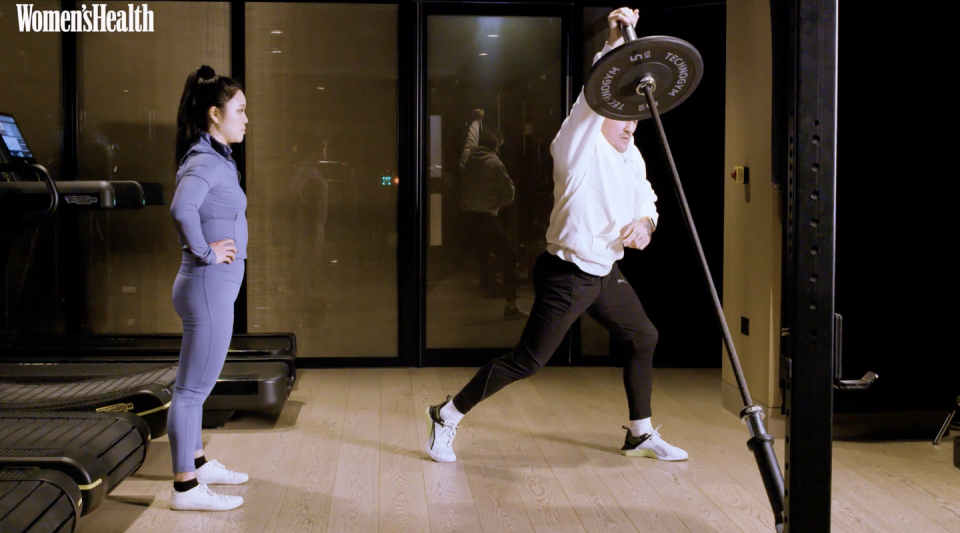
How to do the move:
A) Angle your knee and ankle in line with the head of the bar. Keep your knee away from your toe - don't lean forward so far that your front heel comes off the floor. Keep your back and chest up, with the weight in your back knee - you almost want to be forming two right angles with your knees.
B) Catch the head of the bar, find your balance, and drive up, bringing your elbow high and keeping the bar close to your body, in front and slightly to the side.
C) Once you're at the peak of the high row, twist your feet and use your other arm to catch the head of the bar. Rotate through and push the weight overhead and away from you.
D) Don't be caught out as you come down in the negative part of the movement. Catch the bar, keep your posture strong and your chest up as you return to the starting position.
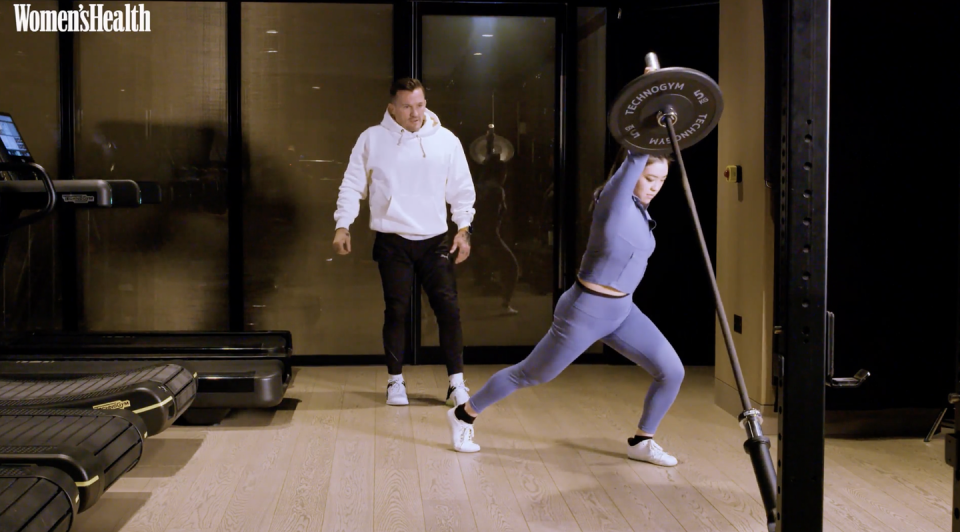
b) Deadlift
The 'old-fashioned deadlift' is 'fundamental for any strength-training programme', says Bobby.
How to do the move:
A) Approach the bar and take your toes underneath. Keep it close to your body throughout the movement.
B) Relax your arms, break and hinge from your hips, push your bum down and keep your chest up. Come down low enough to grip the bar.
Tip: a cue to find your balance is to try and lift your toes up - keep most of the weight in your heels.
C) Your head position is not looking directly up or craning your neck. Your chin is slightly down, looking just in front of you. The position of your head doesn't change throughout the movement.
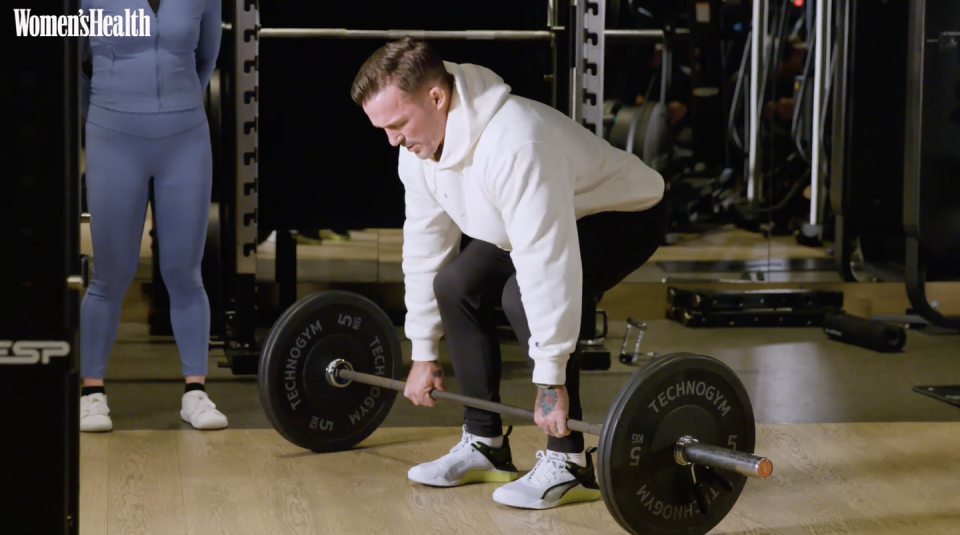
D) Turn your elbows back towards the back of the room to engage your scaps (shoulder blades), lats, and to keep everything locked in.
E) Taking a big deep breath in, lifting up from top of head, drive through your glutes first, and push the floor away as you stand up.
Tip: Keep a neutral spine and don't overextend at the top.
F) To return to the start, keep your shoulders over your hips, break from your hips, pushing the weight back into your heels as you lower down.

c) Single-arm row
A movement that involves 'upper-body pulling', says Bobby.
How to do the move:
A) You'll need the same hand and same knee to start the frame, with your hand a bit further out in front, either under your shoulder or slightly further out. Keep your knee under your hip. Take your supporting leg out just wide enough so it feels secure.
B) Maintain a flat back, with as little rolling as possible. The whole movement is coming through your shoulder blade and elbow. Everything else should be still and solid.
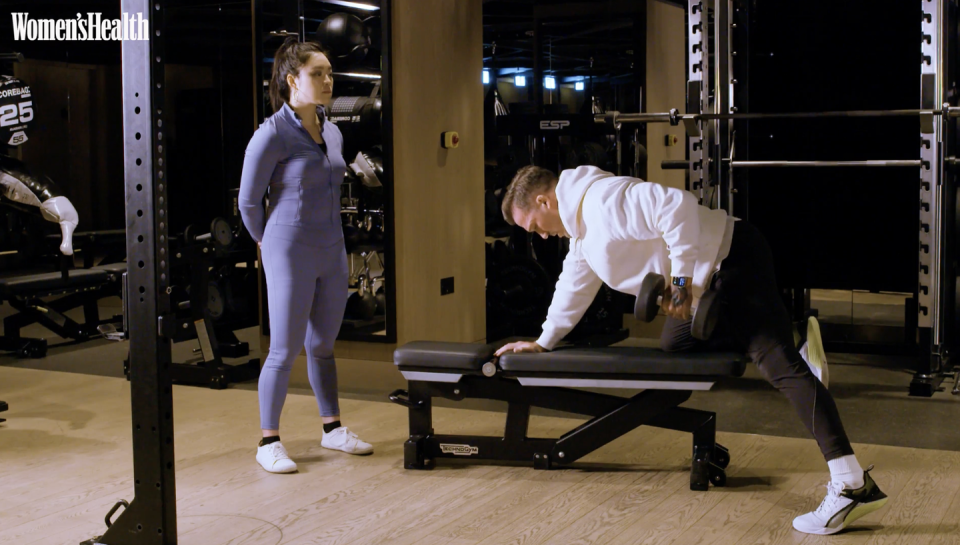
C) There's a common misconception with the single-arm row that the movement is just to pull the dumbbell straight up, having your shoulder near your ear - we want to avoid this. Instead, it's a big smooth movement where you pull the weight slightly back into your pocket, keeping your neck long.
D) Breathe in and breathe out as you pull the dumbbell back. The pull starts from your scapula (shoulder blade), so think about pulling back, as opposed to letting your bicep do all the work and dragging the weight up.

Related stories:
'I trained with Dakota Johnson's PT, and learned so many handy hacks'
Zendaya shares full workout and tennis training regime for her role in Challengers
You Might Also Like


